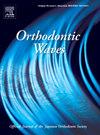咀嚼过程中鼻塞对前额叶皮层活动的影响
IF 0.5
Q4 DENTISTRY, ORAL SURGERY & MEDICINE
引用次数: 0
摘要
摘要目的:本研究旨在阐明实验性鼻塞(NO)对咀嚼时前额叶激活和下颌运动活动以及不适和呼吸困难感觉的影响。方法与材料:选取18名健康志愿者作为研究对象。在咀嚼和想象任务后,使用视觉模拟量表(VAS)测定鼻呼吸(NB)和NO的不适意识水平和呼吸困难感。通过NO和NB的建立,分析受试者在咀嚼过程中咀嚼路径宽度、周期持续时间、咀嚼速度、咀嚼循环次数和预吞期持续时间。FNIRS装置(Hb131S, system Inc., Japan)用于测量前额皮质活动。结果:与NB相比,NO状态下患者的不适感和呼吸困难感明显增加。此外,与NB相比,NO组的周期持续时间和咀嚼周期数量显著增加,而吞咽前阶段的周期数量显著减少。此外,与NB相比,NO咀嚼时的前额叶活动显著降低。结论:咀嚼时鼻塞可能导致前额叶活动下降,伴有舒适度下降和呼吸困难,并调节下颌运动活动。本文章由计算机程序翻译,如有差异,请以英文原文为准。
Effects of nasal obstruction on prefrontal cortex activities during chewing
ABSTRACT Purpose: This study was conducted to clarify the effects of experimentally induced nasal obstruction (NO) on prefrontal activation and jaw movement activities, as well as feelings of discomfort and dyspnoea during chewing. Methods and materials: Eighteen healthy volunteers were enrolled as subjects. The levels of awareness of discomfort and sense of dyspnoea with nasal breathing (NB) and NO were determined using a visual analogue scale (VAS) following chewing and imagery tasks. Masticatory movements were analysed for masticatory path width, cycle duration, masticatory velocity, number of masticatory cycles, and duration of pre-swallowing phase during mastication in the subjects with establishment of NO and NB. An FNIRS device (Hb131S, astem Inc., Japan) was used to measure prefrontal cortex activities. Results: Discomfort and feelings of dyspnoea under the NO condition were significantly increased as compared with NB. Also, cycle duration with NO was significantly increased as well as the number of masticatory cycles, whereas those in the pre-swallowing phase were significantly decreased as compared to NB. Furthermore, prefrontal activities during chewing with NO were significantly decreased as compared to NB. Conclusion: These results indicate that nasal obstruction during chewing may induce a decline in prefrontal activities, accompanied with deterioration comfort and dyspnoea, and modulated jaw movement activities.
求助全文
通过发布文献求助,成功后即可免费获取论文全文。
去求助
来源期刊

Orthodontic Waves
DENTISTRY, ORAL SURGERY & MEDICINE-
CiteScore
0.40
自引率
0.00%
发文量
0
期刊介绍:
Orthodontic Waves is the official publication of the Japanese Orthodontic Society. The aim of this journal is to foster the advancement of orthodontic research and practice. The journal seeks to publish original articles (i) definitive reports of wide interest to the orthodontic community, (ii) Case Reports and (iii) Short Communications. Research papers stand on the scientific basis of orthodontics. Clinical topics covered include all techniques and approaches to treatment planning. All submissions are subject to peer review.
 求助内容:
求助内容: 应助结果提醒方式:
应助结果提醒方式:


